16.1. 래스터 속성 대화창
래스터 레이어의 속성을 살펴보고 설정하려면, 맵 범례에 있는 레이어명을 더블클릭하거나 또는 레이어명을 오른쪽 클릭한 다음 컨텍스트 메뉴에서 Properties 를 선택하십시오. Raster Layer Properties 대화창이 열릴 것입니다.
이 대화창에는 다음과 같은 탭들이 있습니다:
|
||
|
|
|
External plugins[2] tabs |
[1] Also available in the Layer styling panel
[2] External plugins you install can optionally add tabs to this dialog. Those are not presented in this document. Refer to their documentation.
팁
실시간 렌더링 업데이트
레이어 스타일 작업 패널 은 레이어 속성 대화창의 공통 기능 가운데 일부를 제공하며, 레이어 스타일 환경 설정을 빠르게 할 수 있고 맵 캔버스에서 사용자 살펴볼 수 있는 훌륭한 모달리스 위젯입니다.
참고
원본 프로젝트 파일에서 삽입 레이어(Embedding layers from external projects 참조)의 속성들(심볼, 라벨, 액션, 기본값, 양식 등등)을 읽어오기 때문에, 이 습성을 방해할 수도 있는 변경 사항이 적용되는 일을 피하기 위해 삽입 레이어에 대해 레이어 속성 대화창을 사용할 수 없게 돼 있습니다.
16.1.1. 정보 속성
 Information 탭은 읽기 전용으로, 현재 레이어에 대한 요약 정보 및 메타데이터를 한 눈에 볼 수 있는 흥미로운 장소입니다. 다음과 같은 정보를 제공합니다:
Information 탭은 읽기 전용으로, 현재 레이어에 대한 요약 정보 및 메타데이터를 한 눈에 볼 수 있는 흥미로운 장소입니다. 다음과 같은 정보를 제공합니다:
general such as name in the project, source path, list of auxiliary files, last save time and size, the used provider
based on the provider of the layer: extent, width and height, data type, GDAL driver, bands statistics
the Coordinate Reference System: name, units, method, accuracy, reference (i.e. whether it’s static or dynamic)
read from layer properties: data type, extent, width/height, compression, pixel size, statistics on bands, number of columns, rows and no-data values of the raster…
picked from the filled metadata: access, extents, links, contacts, history…
16.1.2. 소스 속성
 Source 탭은 선택한 래스터에 대한 다음과 같은 기본 정보를 표시합니다:
Source 탭은 선택한 래스터에 대한 다음과 같은 기본 정보를 표시합니다:
Layer name: Layers Panel 에 표시될 레이어명
Coordinate Reference System: 레이어의 좌표계 를 표시합니다. 드롭다운 목록에서 최근 사용한 좌표계를 선택하거나
 Select CRS 버튼을 (좌표계 선택기 참조) 클릭해서 레이어 좌표계를 변경할 수 있습니다. 레이어에 적용된 좌표계가 틀렸거나 또는 적용된 좌표계가 없는 경우에만 변경하십시오. 사용자 데이터를 다른 좌표계로 재투영하고 싶은 경우, 공간 처리 재투영 알고리즘을 이용하거나 새 데이터셋으로 레이어를 저장 하는 편이 좋습니다.
Select CRS 버튼을 (좌표계 선택기 참조) 클릭해서 레이어 좌표계를 변경할 수 있습니다. 레이어에 적용된 좌표계가 틀렸거나 또는 적용된 좌표계가 없는 경우에만 변경하십시오. 사용자 데이터를 다른 좌표계로 재투영하고 싶은 경우, 공간 처리 재투영 알고리즘을 이용하거나 새 데이터셋으로 레이어를 저장 하는 편이 좋습니다.
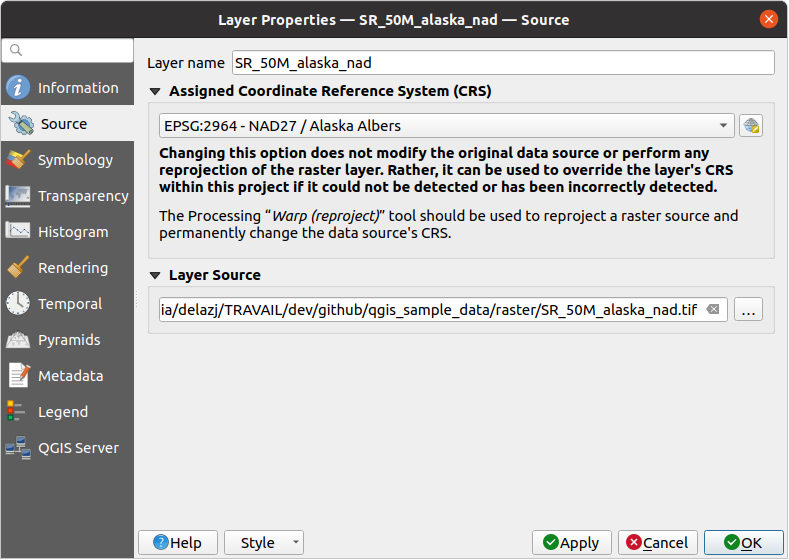
그림 16.1 래스터 레이어 속성 ─ 소스 대화창
16.1.3. 심볼 속성
The raster layer symbology tab is made of three different sections:
The Band rendering where you can control the renderer type to use
The Layer rendering to apply effects on rendered data
The Resampling methods to optimize rendering on map
16.1.3.1. 밴드 렌더링
QGIS는 서로 다른 Render types 를 여럿 제공하고 있습니다. 데이터 유형 및 사용자가 강조하고자 하는 정보에 따라 렌더링 작업자를 선택합니다.
다중 밴드 색상: 파일이 밴드 여러 개를 가지고 있는 경우 (예: 여러 밴드를 가진 위성 이미지)
팔레트/유일값: 인덱스가 적용된 팔레트를 가지고 있는 단일 밴드 파일 (예: 디지털 지형도) 또는 래스터 레이어 렌더링을 위한 팔레트의 일반적인 활용을 위한 경우
단일 밴드 회색조: 이미지(의 밴드 하나)를 회색조로 렌더링할 것입니다. QGIS는 파일이 다중 밴드도 아니고 팔레트도 가지고 있지 않을 경우 (예: 음영기복도) 이 렌더링 작업자를 선택할 것입니다.
단일 밴드 의사색상: 연속적인 팔레트 또는 색상표를 가지고 있는 파일의 경우 (예: 표고 지도) 이 렌더링 작업자를 사용할 수 있습니다.
음영기복: 밴드로부터 음영기복을 생성합니다.
등고선: 소스 래스터 밴드에 대해 등고선을 실시간으로(on the fly) 생성합니다.
다중 밴드 색상
다중 밴드 색상 렌더링 작업자는 이미지에서 선택한 밴드 3개를 렌더링합니다. 각 밴드는 색상 이미지의 빨간색(R), 초록색(G), 파란색(B) 요소로 쓰입니다. QGIS는 래스터의 각 밴드에서 Min 과 Max 값을 자동적으로 가져와 그에 따라 색상 작업을 조정합니다. 최소/최대 값 설정 부분에서 값의 범위를 제어할 수 있습니다.
값에 적용할 수 있는 Contrast enhancement 방법을 ‘No enhancement’, ‘Stretch to MinMax’, ‘Stretch and clip to MinMax’ 그리고 ‘Clip to min max’ 가운데 선택할 수 있습니다.
참고
대조 개선
GRASS 래스터를 추가하면, QGIS 전체 수준 옵션에서 어떤 값으로 설정돼 있건 상관없이, 자동적으로 Contrast enhancement 옵션이 항상 stretch to min max 로 설정될 것입니다.
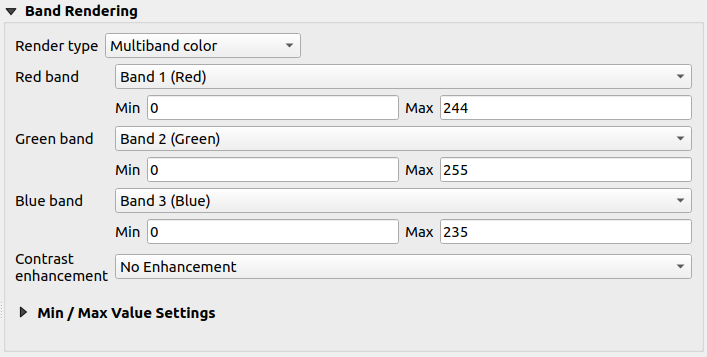
그림 16.2 래스터 심볼 ─ 다중 밴드 색상 렌더링
팁
다중 밴드 래스터의 단일 밴드 살펴보기
다중 밴드 이미지의 단일 밴드를 (예를 들어 빨간색 밴드를) 살펴보고 싶다면, 초록색과 파란색 밴드를 Not Set 으로 설정해야 한다고 생각할 수도 있습니다. 그러나 그건 정확한 방법이 아닙니다. 빨간색 밴드만 표시하려면, 이미지 유형을 단일 밴드 회색조 로 설정한 다음 Gray band 를 빨간색으로 선택하십시오.
팔레트/유일값
각 픽셀값에 특정 생상을 할당한 색상표를 가지고 있는 단일 밴드 파일을 위한 표준 렌더링 옵션입니다. 이런 경우, 팔레트를 자동적으로 렌더링합니다.
래스터의 각 유일값에 색상을 할당해서 모든 유형의 래스터 밴드에 사용할 수 있습니다.
어떤 색상을 변경하고 싶은 경우, 해당 색상을 더블클릭하기만 하면 Select color 대화창이 열립니다.
색상에 라벨도 적용할 수 있습니다. 이 라벨은 래스터 레이어의 범례에 표시됩니다.
색상표에서 선택한 행들을 오른쪽 클릭하면 다음 옵션을 가진 컨텍스트 메뉴가 나타납니다:
Change Color…: 선택 집합의 색상을 변경합니다.
Change Opacity… 선택 집합의 투명도를 변경합니다.
Change Label…: 선택 집합의 라벨을 변경합니다.
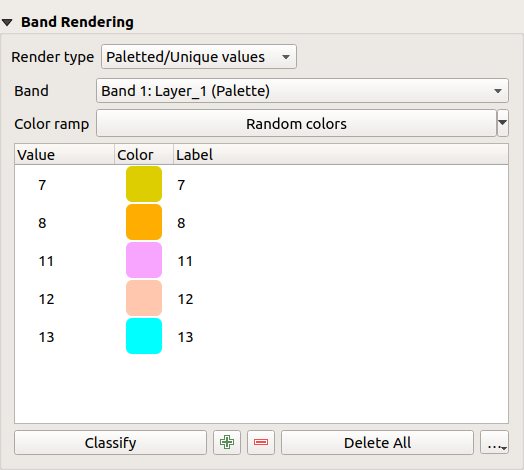
그림 16.3 래스터 심볼 ─ 팔레트/유일값 렌더링
The pulldown menu, that opens when clicking the … (Advanced options) button below the color map to the right, offers color map loading (Load Color Map from File…) and exporting (Export Color Map to File…), and loading of classes (Load Classes from Layer).
단일 밴드 회색조
This renderer allows you to render a layer using only one band with a Color gradient: ‘Black to white’ or ‘White to black’. You can change the range of values to color (Min and Max) in the Min/Max Value Settings.
값에 적용할 수 있는 Contrast enhancement 방법을 ‘No enhancement’, ‘Stretch to MinMax’, ‘Stretch and clip to MinMax’ 그리고 ‘Clip to min max’ 가운데 선택할 수 있습니다.
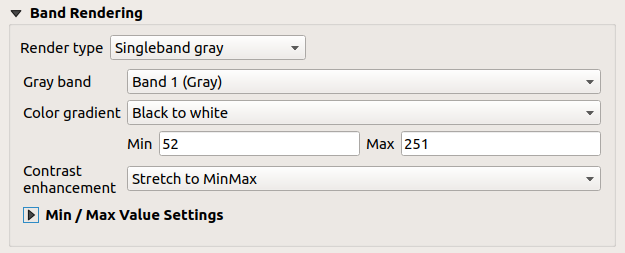
그림 16.4 래스터 심볼 ─ 단일 밴드 회색조 렌더링
Pixels are assigned a color based on the selected color gradient and the layer’s legend (in the Layers panel and the layout legend item) is displayed using a continuous color ramp. Press Legend settings… if you wish to tweak the settings. More details at Customize raster legend.
단일 밴드 의사색상
This is a render option for single-band files that include a continuous palette. You can also create color maps for a band of a multiband raster.
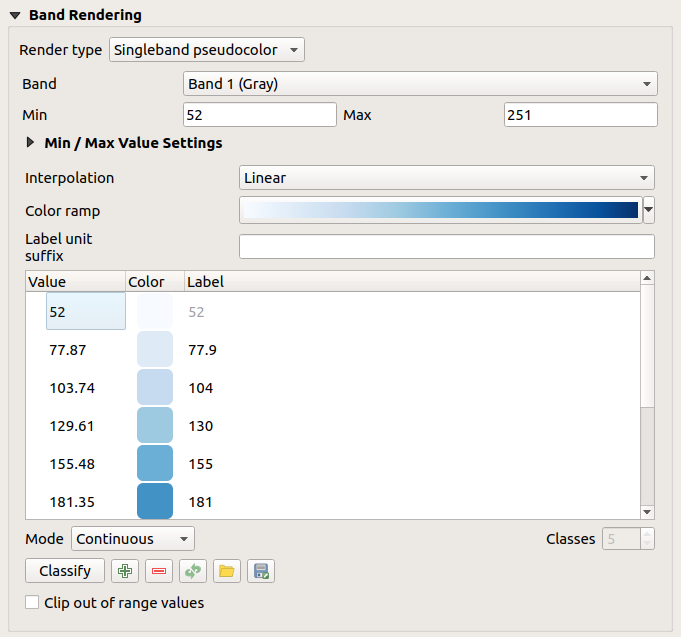
그림 16.5 래스터 심볼 ─ 단일 밴드 의사색상 렌더링
Using a Band of the layer and a values range, you can now interpolate and assign representation color to pixels within classes. More at Color ramp shader classification.
Pixels are assigned a color based on the selected color ramp and the layer’s legend (in the Layers panel and the layout legend item) is displayed using a continuous color ramp. Press Legend settings… if you wish to tweak the settings or instead use a legend with separated classes (and colors). More details at Customize raster legend.
음영기복
음영기복을 사용해서 래스터 레이어의 밴드를 렌더링합니다.
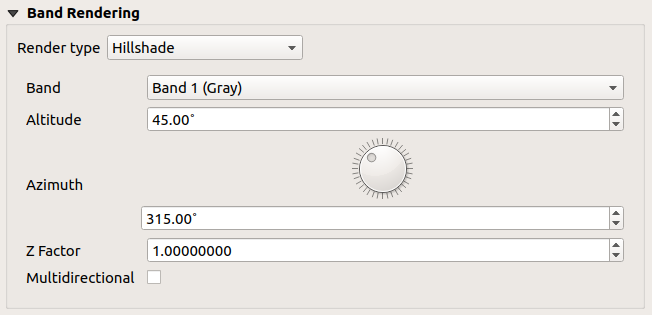
그림 16.6 래스터 심볼 ─ 음영기복 렌더링
옵션:
등고선
이 렌더링 작업자는 소스 래스터 밴드로부터 실시간으로(on the fly) 계산한 등고선을 그립니다.

그림 16.7 래스터 심볼 - 등고선 렌더링
옵션:
Input band: 사용할 래스터 밴드
Contour interval: 연속된 두 등고선 라인 사이의 거리
Contour symbol: 등고선 라인에 공통으로 적용할 심볼
Index contour interval: 연속된 두 색인 등고선(index contour) 사이의 거리로, 색인 등고선이란 식별하기 쉽도록 눈에 띄는 방식으로 표시된 라인을 말합니다. 일반적으로 다른 등고선 라인보다 더 진하게 인쇄되고, 라인을 따라 값 라벨이 붙습니다.
Index contour symbol: 색인 등고선 라인에 적용할 심볼
Input downscaling: 렌더링 작업자가 데이터 제공자에 전송할 요청을 얼마나 축소(downscale)할 것인지를 나타냅니다. (기본값은
4.0입니다.)예를 들어, 입력 래스터 블록의 등고선을 산출 래스터 블록과 동일한 크기로 생성하는 경우, 생성된 라인이 너무 많은 세부 정보를 담고 있을 수 있습니다. 소스 래스터를 더 낮은 해상도로 요청하는 “축소” 인자로 이 세부 정보를 줄일 수 있습니다. 축소 인자를 10으로 설정하면, 렌더링 작업자가 제공자에 1000x500 크기의 래스터 블록을 100x50 크기로 요청할 것입니다. 축소 인자가 클수록 등고선이 더 단순화됩니다. (일부 세부 정보는 누락되겠지만 말이죠.)
최소/최대 값 설정하기
QGIS는 래스터의 밴드(들)의 Min 및 Max 값을 기본적으로 보고합니다. 너무 낮은 그리고/또는 너무 높은 몇몇 값들은 래스터를 렌더링하는 데 부정적인 영향을 줄 수 있습니다. Min/Max Value Settings 프레임에서 렌더링을 제어할 수 있습니다.
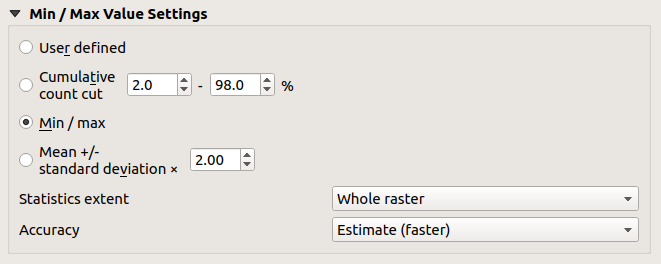
그림 16.8 래스터 심볼 ─ 최소/최대 값 설정하기
다음과 같은 옵션을 사용할 수 있습니다:
 Cumulative count cut: 특이값(outlier)을 제거합니다. 값의 표준 범위는
Cumulative count cut: 특이값(outlier)을 제거합니다. 값의 표준 범위는 2%부터98%까지지만, 사용자가 직접 조정할 수 있습니다. Mean +/- standard deviation x: 표준 편차 또는 다중 표준 편차 안에 떨어지는 값만을 대상으로 색상표를 생성합니다. 래스터 레이어에 래스터 렌더링에 부정적인 영향을 주는 비정상적으로 높은 값을 가진 셀이 한두 개 있을 때 유용합니다.
Mean +/- standard deviation x: 표준 편차 또는 다중 표준 편차 안에 떨어지는 값만을 대상으로 색상표를 생성합니다. 래스터 레이어에 래스터 렌더링에 부정적인 영향을 주는 비정상적으로 높은 값을 가진 셀이 한두 개 있을 때 유용합니다.
밴드의 최소/최대 값은 다음을 기반으로 계산됩니다:
Statistics extent: Whole raster, Current canvas 또는 Updated canvas 가운데 선택할 수 있습니다. Updated canvas 는 렌더링에 사용되는 최소/최대 값이 캔버스 범위와 함께 변경될 것이라는 (동적으로 줄거나 늘어날 것이라는) 의미입니다.
Accuracy: Estimate (faster) 또는 Actual (slower) 가운데 선택할 수 있습니다.
참고
일부 설정의 경우, 위젯에 실제 최소/최대 값을 표시하기 위해 레이어 속성 대화창의 Apply 버튼을 눌러야 할 수도 있습니다.
Color ramp shader classification
This method can be used to classify and represent scalar dataset (raster or mesh contour) based on their values. Given a color ramp and a number of classes, it generates intermediate color map entries for class limits. Each color is mapped with a value interpolated from a range of values and according to a classification mode. The scalar dataset elements are then assigned their color based on their class.
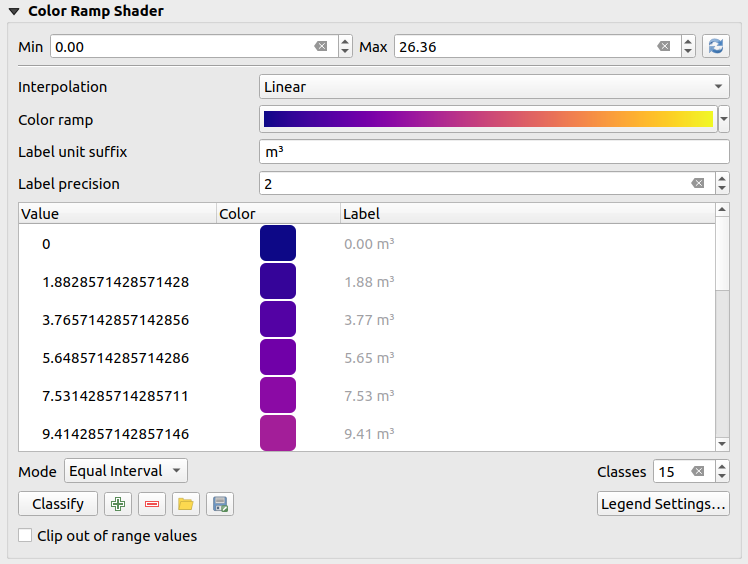
그림 16.9 Classifying a dataset with a color ramp shader
A Min and Max values must be defined and used to interpolate classes bounds. By default QGIS detects them from the dataset but they can be modified.
The Interpolation entry defines how scalar elements are assigned their color :
Discrete (a
<=symbol appears in the header of the Value column): The color is taken from the closest color map entry with equal or higher valueLinear: The color is linearly interpolated from the color map entries above and below the pixel value, meaning that to each dataset value corresponds a unique color
Exact (a
=symbol appears in the header of the Value column): Only pixels with value equal to a color map entry are applied a color; others are not rendered.
The Color ramp widget helps you select the color ramp to assign to the dataset. As usual with this widget, you can create a new one and edit or save the currently selected one. The name of the color ramp will be saved in the configuration.
The Label unit suffix adds a label after the value in the legend, and the Label precision controls the number of decimals to display.
The classification Mode helps you define how values are distributed across the classes:
Equal interval: Provided the Number of classes, limits values are defined so that the classes all have the same magnitude.
Continuous: Classes number and color are fetched from the color ramp stops; limits values are set following stops distribution in the color ramp.
Quantile: Provided the Number of classes, limits values are defined so that the classes have the same number of elements. Not available with mesh layers.
You can then Classify or tweak the classes:
The button
 Remove selected row deletes selected values
from the table.
Remove selected row deletes selected values
from the table.Double clicking in the Value column lets you modify the class value.
Double clicking in the Color column opens the dialog Change color, where you can select a color to apply for that value.
Double clicking in the Label column to modify the label of the class, but this value won’t be displayed when you use the identify feature tool.
Right-clicking over selected rows in the color table shows a contextual menu to Change Color… and Change Opacity… for the selection.
 Load color map from file 또는
Load color map from file 또는  Export color map to file 버튼을 이용해서 기존 색상표를 불러오거나 또는 다른 세션을 위해 색상표를 저장할 수도 있습니다.
Export color map to file 버튼을 이용해서 기존 색상표를 불러오거나 또는 다른 세션을 위해 색상표를 저장할 수도 있습니다.With linear Interpolation, you can also configure:
 Clip out of range values: By default, the linear
method assigns the first class (respectively the last class) color to
values in the dataset that are lower than the set Min
(respectively greater than the set Max) value.
Check this setting if you do not want to render those values.
Clip out of range values: By default, the linear
method assigns the first class (respectively the last class) color to
values in the dataset that are lower than the set Min
(respectively greater than the set Max) value.
Check this setting if you do not want to render those values.Legend settings, for display in the Layers panel and the layout legend item. More details at Customize raster legend.
Customize raster legend
When applying a color ramp to a raster or a mesh layer, you may want to display a legend showing the classification. By default, QGIS displays a continuous color ramp with min and max values in the Layers panel and the layout legend item. This can be customized using the Legend settings button in the classification widget.
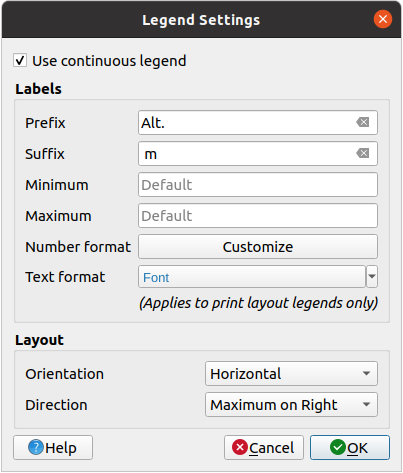
그림 16.10 Modifying a raster legend
In this dialog, you can set whether to  Use continuous
legend: if unchecked, the legend displays separated colors corresponding to
the different classes applied. This option is not available for raster
singleband gray symbology.
Use continuous
legend: if unchecked, the legend displays separated colors corresponding to
the different classes applied. This option is not available for raster
singleband gray symbology.
Checking the Use continuous legend allows you to configure both the labels and layout properties of the legend.
Labels
Add a Prefix and a Suffix to the labels
Modify the Minimum and a Maximum values to show in the legend
Customize the Number format
Customize the Text format to use in the print layout legend.
Layout
Control the Orientation of the legend color ramp; it can be Vertical or Horizontal
Control the Direction of the values depending on the orientation:
If vertical, you can display the Maximum on top or the Minimum on top
If horizontal, you can display the Maximum on right or the Minimum on right
16.1.3.2. Layer rendering
Over the symbology type applied to the layer band(s), you can achieve special rendering effects for the whole raster file(s):
Use one of the blending modes (see 혼합 모드)
Set custom Brightness, Saturation, Gamma and Contrast to colors.
With the
 Invert colors, the layer is rendered with
opposite colors. Handy, for example, to switch out-of-the box OpenStreetMap
tiles to dark mode.
Invert colors, the layer is rendered with
opposite colors. Handy, for example, to switch out-of-the box OpenStreetMap
tiles to dark mode.Turn the layer to Grayscale option either ‘By lightness’, ‘By luminosity’ or ‘By average’.
Colorize and adjust the Strength of Hue in the color table
Press Reset to remove any custom changes to the layer rendering.

그림 16.11 Raster Symbology - Layer rendering and Resampling settings
16.1.3.3. 리샘플링
Resampling 옵션의 효과는 사용자가 이미지를 확대/축소하는 경우 나타납니다. 리샘플링 모드로 맵의 모습을 최적화할 수 있습니다. 리샘플링 모드들은 기하학적 변형을 통해 새 회색조 값 매트릭스를 생성합니다.
‘최근접 이웃(Nearest neighbour)’ 방법을 적용하면, 확대 시 맵의 픽셀이 두드러져 보일 수 있습니다. ‘이중선형(Bilinear)’ 또는 ‘3차(Cubic)’ 방법을 사용하면 이 모습을 향상시킬 수 있는데, 이 방법들은 뚜렷한 경계를 흐릿하게 만듭니다. 이 흐리기 효과로 더 평탄화된 이미지를 생성할 수 있습니다. 예를 들자면 래스터 수치지형도에 이 방법을 적용할 수 있습니다.
16.1.4. 투명도 속성
 QGIS provides capabilities to set the transparency level
of a raster layer.
QGIS provides capabilities to set the transparency level
of a raster layer.
Use the Global opacity slider to set to what extent the underlying layers (if any) should be visible through the current raster layer. This is very useful if you overlay raster layers (e.g., a shaded relief map overlayed by a classified raster map). This will make the look of the map more three dimensional. The opacity of the raster can be data-defined, and vary e.g. depending on the visibility of another layer, by temporal variables, on different pages of an atlas, …
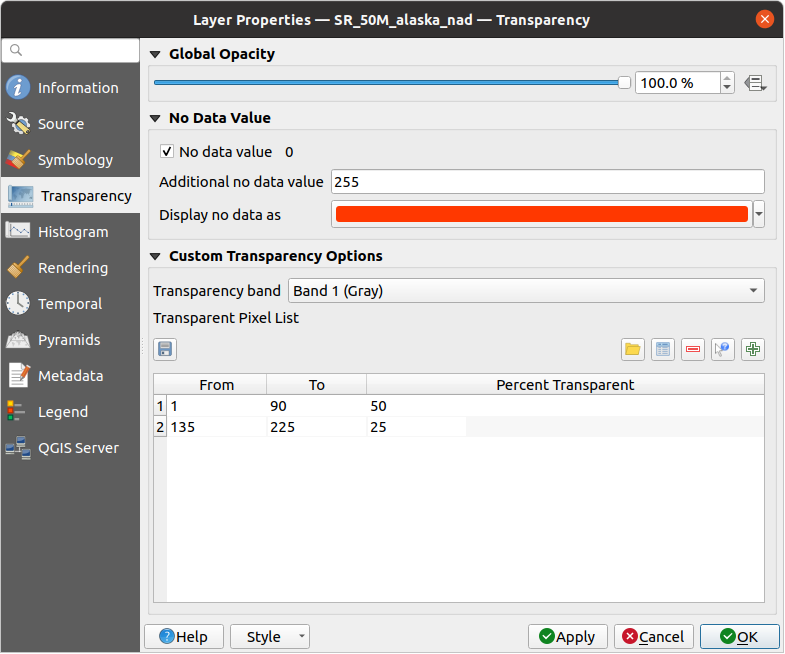
그림 16.12 래스터 투명도
With  No data value QGIS reports the original source
no data value (if defined) which you can consider as is in the rendering.
Additionally, you can enter a raster value that should be treated as
an Additional no data value.
The Display no data as color selector allows you to apply
a custom color to no data pixels, instead of the default transparent rendering.
No data value QGIS reports the original source
no data value (if defined) which you can consider as is in the rendering.
Additionally, you can enter a raster value that should be treated as
an Additional no data value.
The Display no data as color selector allows you to apply
a custom color to no data pixels, instead of the default transparent rendering.
Custom transparency options 부분에서 투명도를 훨씬 융통성 있게 사용자 지정할 수 있습니다:
Transparency band 옵션을 통해 전체 밴드에 적용될 투명도를 설정하십시오.
대응하는 투명도 수준으로 투명하게 할 픽셀 목록을 지정하십시오:
픽셀의 빨간색, 초록색, 파란색 값을 입력한 다음 적용할 투명도 백분율 을 조정하십시오.
그 대신에,
 Add values from display 버튼으로 래스터에서 픽셀 값을 직접 가져올 수도 있습니다. 그 다음 투명도 값을 입력하십시오.
Add values from display 버튼으로 래스터에서 픽셀 값을 직접 가져올 수도 있습니다. 그 다음 투명도 값을 입력하십시오.더 많은 값을 사용자 지정 투명도로 조정하려면 앞 단계를 반복하십시오.
Apply 버튼을 클릭한 다음 맵을 살펴보십시오.
이처럼 사용자 지정 투명도를 설정하는 일은 꽤 쉬운 편이지만, 반복 작업을 오래 해야 할 수도 있습니다. 따라서,
 Export to file 아이콘을 이용해서 사용자의 투명도 목록을 파일로 저장할 수 있습니다.
Export to file 아이콘을 이용해서 사용자의 투명도 목록을 파일로 저장할 수 있습니다.  Import from file 아이콘은 사용자의 투명도 설정을 불러와 현재 래스터 레이어에 적용시킵니다.
Import from file 아이콘은 사용자의 투명도 설정을 불러와 현재 래스터 레이어에 적용시킵니다.
16.1.5. 히스토그램 속성
 Histogram 탭에서 사용자 래스터에 있는 값의 분포를 살펴볼 수 있습니다. Compute Histogram 버튼을 클릭하면 히스토그램을 자동적으로 생성합니다. 모든 기존 밴드를 함께 표시할 것입니다.
Histogram 탭에서 사용자 래스터에 있는 값의 분포를 살펴볼 수 있습니다. Compute Histogram 버튼을 클릭하면 히스토그램을 자동적으로 생성합니다. 모든 기존 밴드를 함께 표시할 것입니다.  아이콘을 클릭하면 히스토그램을 이미지로 저장할 수 있습니다.
아이콘을 클릭하면 히스토그램을 이미지로 저장할 수 있습니다.
히스토그램 하단의 드롭다운 메뉴에서 래스터 밴드를 선택하고, Set min/max style for 를 통해 해당 밴드의 최소/최대 스타일을 설정할 수 있습니다.  Prefs/Actions 드롭다운 메뉴는 히스토그램을 사용자 지정할 수 있는 고급 옵션을 제공합니다:
Prefs/Actions 드롭다운 메뉴는 히스토그램을 사용자 지정할 수 있는 고급 옵션을 제공합니다:
Visibility 옵션을 통해 개별 밴드의 히스토그램을 표시할 수 있는데, 먼저
 Show selected band 옵션을 선택해야 합니다.
Show selected band 옵션을 선택해야 합니다.Min/max options 에서 ‘Always show min/max markers’, ‘Zoom to min/max’ 그리고 ‘Update style to min/max’ 가운데 하나를 선택할 수 있습니다.
밴드(들)의 최소 또는 최대값을 변경한 후, Actions 옵션에서 ‘Reset’ 또는 ‘Recompute histogram’ 가운데 하나를 선택해서 히스토그램을 다시 계산할 수 있습니다.
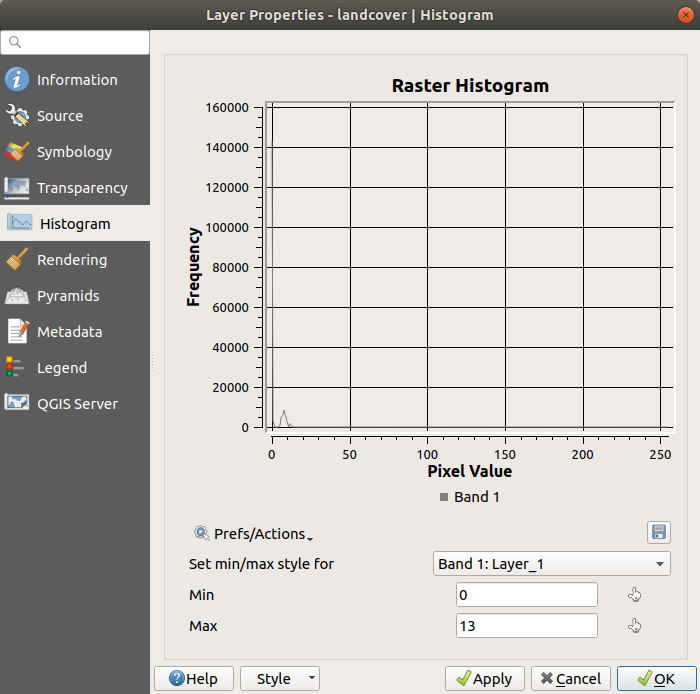
그림 16.13 래스터 히스토그램
16.1.6. 렌더링 속성
 Rendering 탭에서 다음 설정을 할 수 있습니다:
Rendering 탭에서 다음 설정을 할 수 있습니다:
레이어의 Scale dependent visibility 설정: Maximum (inclusive) 및 Minimum (exclusive) 축척을 설정해서 피처가 보이게 될 축척 범위를 정의할 수 있습니다. 이 범위를 벗어나면, 피처를 숨깁니다.
 Set to current canvas scale 버튼을 클릭하면 현재 맵 캔버스의 축척을 가시성 범위의 한계값으로 설정할 수 있습니다. 자세한 내용은 축척에 따른 렌더링 을 참조하세요.
Set to current canvas scale 버튼을 클릭하면 현재 맵 캔버스의 축척을 가시성 범위의 한계값으로 설정할 수 있습니다. 자세한 내용은 축척에 따른 렌더링 을 참조하세요.Refresh layer at interval (seconds): 개별 레이어들을 자동으로 새로고침하는 타이머를 설정합니다. 하나 이상의 레이어에 자동 업데이트 간격을 설정한 경우 여러번 새로고침하지 않도록 캔버스 업데이트를 연기합니다.
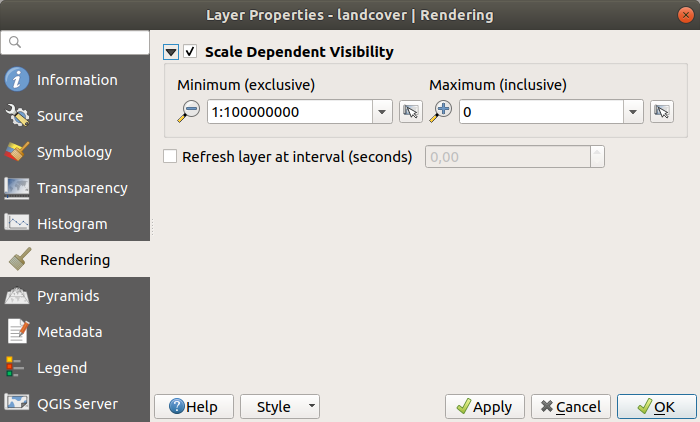
그림 16.14 Raster Rendering Properties
16.1.7. Temporal Properties
The  Temporal tab provides options to control
the rendering of the layer over time. Such dynamic rendering requires the
temporal navigation to be enabled over the map canvas.
Temporal tab provides options to control
the rendering of the layer over time. Such dynamic rendering requires the
temporal navigation to be enabled over the map canvas.
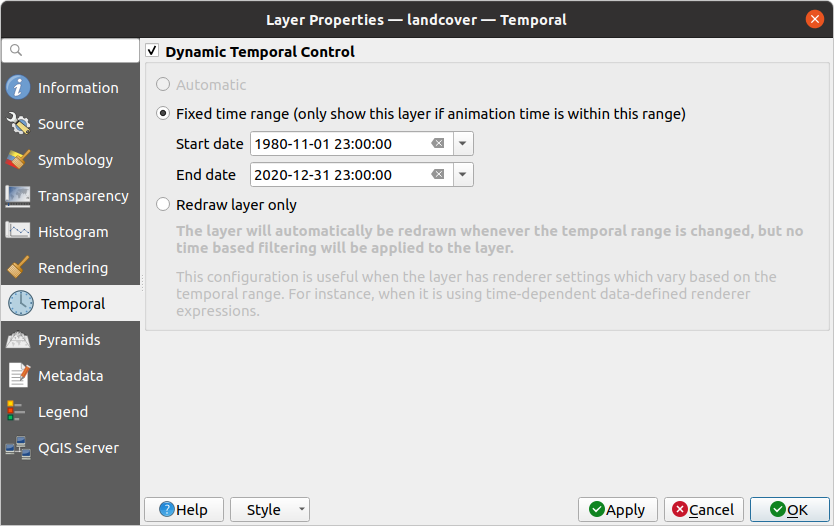
그림 16.15 Raster Temporal Properties
Check the  Dynamic Temporal Control option and
set whether the layer redraw should be:
Dynamic Temporal Control option and
set whether the layer redraw should be:
Automatic: the rendering is controlled by the underlying data provider if it suppports temporal data handling. E.g. this can be used with WMS-T layers or PostGIS rasters.
Fixed time range: only show the raster layer if the animation time is within a Start date and End date range
Redraw layer only: the layer is redrawn at each new animation frame. It’s useful when the layer uses time-based expression values for renderer settings (e.g. data-defined renderer opacity, to fade in/out a raster layer).
16.1.8. 피라미드 속성
고해상도 래스터 레이어는 QGIS의 맵 탐색 속도를 느리게 할 수 있습니다. 이때 더 낮은 해상도를 가진 데이터 복사본들(피라미드)을 생성하면, QGIS가 확대/축소 수준에 따라 가장 알맞는 해상도를 선택하기 때문에 성능을 크게 개선할 수 있습니다.
피라미드를 생성하려면 원본 데이터가 저장돼 있는 디렉터리에 쓰기 권한을 가지고 있어야만 합니다.
Resolutions 목록에서, 해상도를 클릭해서 피라미드 수준을 생성하려는 해상도를 선택하십시오.
Overview format 드롭다운 목록에서 Internal (if possible) 을 선택한 경우, QGIS는 피라미드를 원본 파일 내부에 생성하려 할 것입니다.
참고
피라미드 생성 작업이 원본 데이터 파일을 변경시킬 수도 있으며, 생성 후엔 제거할 수 없다는 점을 기억하십시오. 사용자 래스터의 ‘피라미드가 아닌’ 버전을 보존하고 싶다면, 피라미드를 생성하기 전에 백업하십시오.
External 및 External (Erdas Imagine) 을 선택한 경우, 원본 래스터 파일이 있는 디렉터리에 피라미드를 동일한 파일명과 .ovr 확장자를 가진 파일로 생성할 것입니다.
피라미드를 계산하는 데 다음 몇몇 Resampling methods 를 사용할 수 있습니다:
최근접 이웃(Nearest Neighbour)
평균(Average)
가우스(Gauss)
3차(Cubic)
3차 스플라인(Cubic Spline)
란초시(Laczos)
모드(Mode)
없음(None)
마지막으로, Build Pyramids 버튼을 클릭해서 생성 과정을 시작하십시오.

그림 16.16 래스터 피라미드
16.1.9. 메타데이터 속성
The  Metadata tab provides you with options
to create and edit a metadata report on your layer.
See Metadata for more information.
Metadata tab provides you with options
to create and edit a metadata report on your layer.
See Metadata for more information.
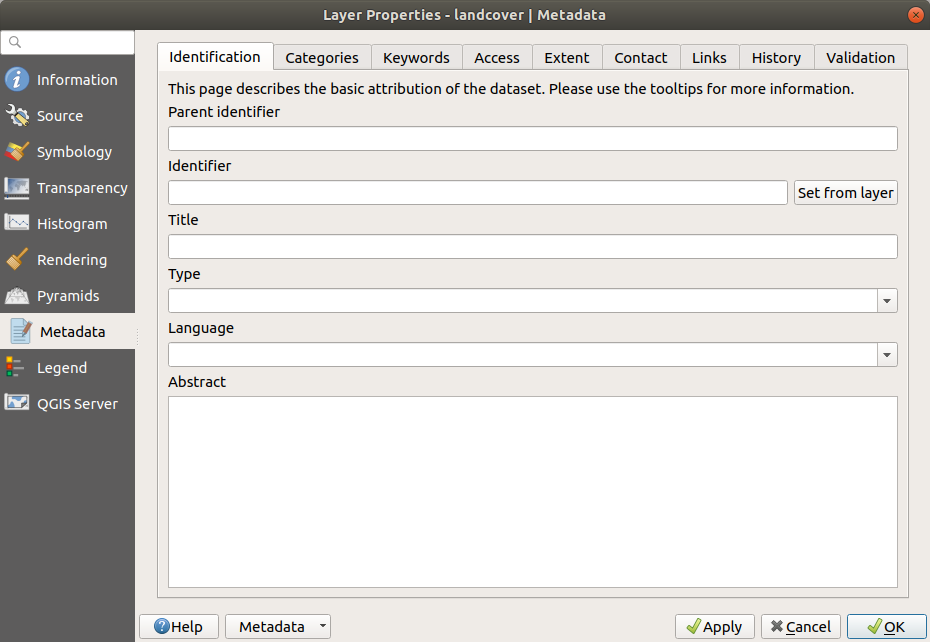
그림 16.17 래스터 메타데이터
16.1.10. 범례 속성
The  Legend tab provides you with advanced
settings for the Layers panel and/or the print
layout legend. These options include:
Legend tab provides you with advanced
settings for the Layers panel and/or the print
layout legend. These options include:
Depending on the symbology applied to the layer, you may end up with several entries in the legend, not necessarily readable/useful to display. The Legend placeholder image helps you select an image for replacement, displayed both in the Layers panel and the print layout legend.
The
 Embedded widgets in Legend provides you with a list
of widgets you can embed within the layer tree in the Layers panel.
The idea is to have a way to quickly access some actions that are
often used with the layer (setup transparency, filtering, selection,
style or other stuff…).
Embedded widgets in Legend provides you with a list
of widgets you can embed within the layer tree in the Layers panel.
The idea is to have a way to quickly access some actions that are
often used with the layer (setup transparency, filtering, selection,
style or other stuff…).QGIS가 기본적으로 투명도 위젯을 제공하고는 있지만, 자체 위젯을 등록하고 플러그인이 관리하는 레이어에 사용자 지정 액션을 할당하는 플러그인으로 위젯 목록을 확장할 수 있습니다.
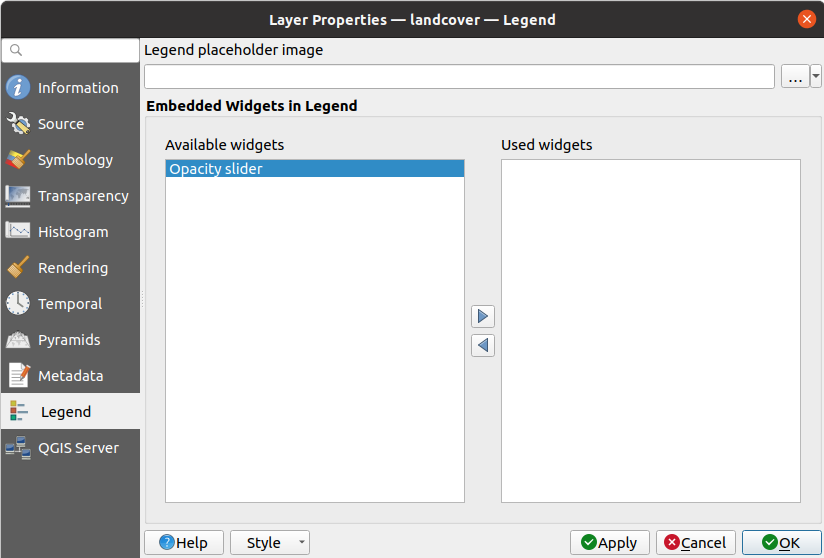
그림 16.18 래스터 범례
16.1.11. QGIS 서버 속성
From the  QGIS Server tab, information can
be provided for Description, Attribution,
Metadata URL and Legend URL.
QGIS Server tab, information can
be provided for Description, Attribution,
Metadata URL and Legend URL.

그림 16.19 래스터 속성에서의 QGIS 서버



